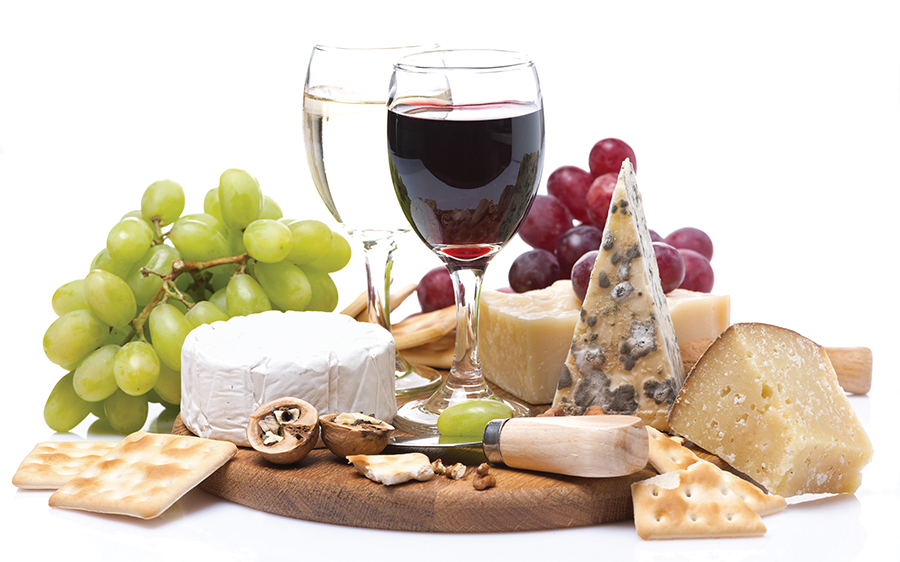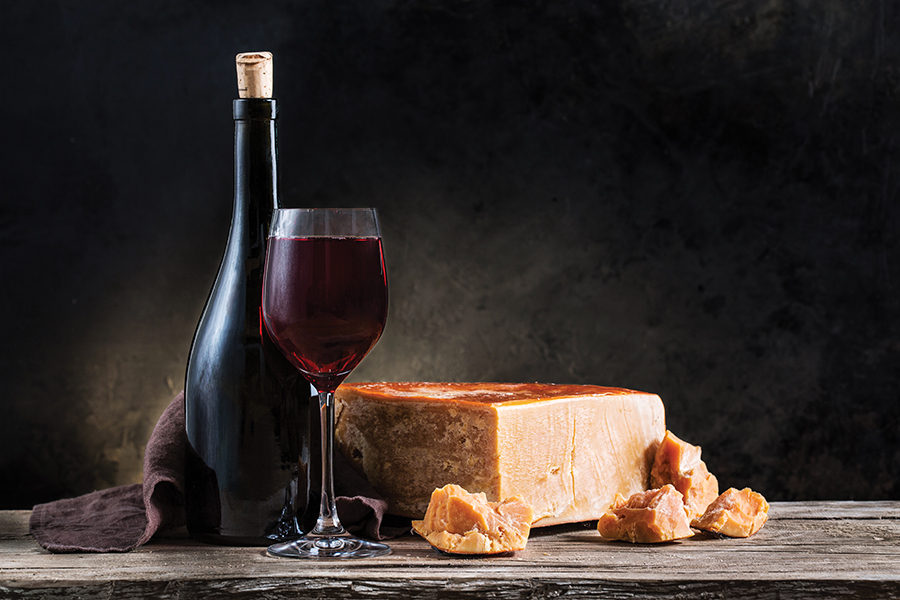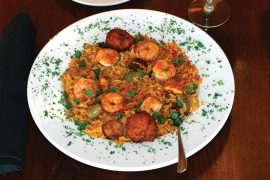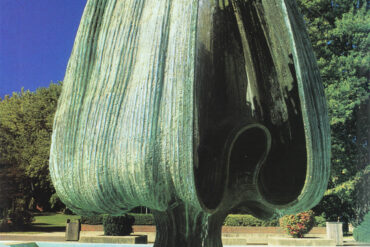By Matthew DeBord
HQ 116 | WINTER 2022
Wine and cheese really are two tastes that go great together, regardless of all the 1970s-era images of slightly pretentious people nibbling and sipping at outdoor concerts and picnics in scenic country settings. In fact, wine and cheese are such natural, historic companions that you’re truly missing out on a beautiful friendship if you don’t periodically pair some vino with some fromage. I say “fromage” to divert for a moment into the historic part: France, the greatest wine-drinking country in the world, is also the greatest cheese-eating country in the word. Few French would ever think of munching on a piece of cheese without downing at least one glass of wine.
Most other cheese-loving nations are also wine obsessed, including France’s enological neighbors, Italy and Spain. But cheese is found almost everywhere in the world, even in some locales where it hasn’t long been a preoccupation, and thus a lack of a cheese-consuming tradition should not be an impediment to enjoying cheese with wine.
In the U.S., we’ve been gobbling cheese for centuries, but only recently have we seen why wine and cheese are wonderful bedfellows. This has led to an explosion of cheese varieties produced in America. We are way past “American” cheese, and we’ve also left classics such as cheddar and Swiss in the dust.
On to the focus of this column, which is how to gracefully pair wine and cheese. This is a somewhat tricky practice; but as with all things related to joining wine and food in happy partnerships, I advocate taking a simple approach.
We’ll start with the cheese. There are three main types: cow, sheep and goat. Broadly speaking, cow-milk cheeses tend to be rich and flavorful and can range from hard versions, such as Parmigiano-Reggiano, to aged classics like Camembert. Sheep cheeses tend to be nutty and medium-firm, while goat cheeses are soft and robustly flavored (there are some firm goat cheeses that are worth seeking out, however).
Now that we’ve established that, my rule for pairing wine with cheese is to start with red wine and work my way through white wines, then sparkling wines, and finally getting into sweet wines. For me red wines go best with rich cow-milk cheeses, and the best one to begin with is good old cheddar, a ubiquitous choice that has suffered in the U.S. from overexposure. Believe me, there are some dandy cheddars, usually the so-called “sharp” ones, that get along well with California Cabernet Sauvignons and Merlots.
Next up, I suggest pairing a nice Italian red, say a decent Chianti, with Parmigiano. Yes, that cheese you grate on pasta is actually great to eat! Cut off small chunks and nibble while you sip. (Truth is, Parmigiano goes with lots of wines, including sparklers, which balance out the sweetness and saltiness.)
What about Pinot Noir? Due to its acidity, I recommend pairing it with goat cheese. The lighter fruit flavors also get along nicely with the richer texture of this type of cheese.

Next, let’s look at some whites. Chardonnay matches well with goat cheese as well, especially if the cheese has herbs mixed in. Chardonnay also pairs nicely with sheep-milk cheese, such as Manchego from Spain. One thing to remember about oft-maligned Chardonnay is that because it can be made in a style that ranges from crisp and oak-free to full-bodied and anything but oak-free, it actually pairs with a wide range of cheeses. For example, Roquefort is a lovely, “moldy” cheese that can really spoil a good Cabernet or red Bordeaux, but not a well-made Chardonnay or white Burgundy.
That said, as we go up the gooey-ness, aged or moldy scale with our cheeses, we want to lean into crisper and more acidic whites that can cut through all that fat and richness. So, with a wedge of Brie, try a Sauvignon Blanc from New Zealand or a Chablis from France. You can even go with a German Riesling that’s on the dry side. And, a flute of Champagne goes well with anything!
Detect a pattern here? As the cheese brings more to the table, flavor- and complexity-wise, you want to dial back what’s happening with the wine, allowing the cheese to be the star of the show. This all reaches a peak with what for me is the greatest wine-and-cheese pairing of them all: English Stilton and Port. Stilton is a sort of intensified blue cheese, a cow-milk concoction that’s so explosively flavorful and rich that it’s rightly a meal on its own. It needs an equally rich wine to be at its best, and Port fits the bill. That’s because Port has the sweetness to enhance Stilton’s lushness but the acidity to keep the fatty aspect of the cheese at bay. A good approach is to make up a plate of small pieces of Stilton to munch while sipping through a bottle of Port, particularly a ruby or vintage Port.
A parting thought: When undertaking a 21st-century wine-and-cheese party, make a plate of one cow-milk, one sheep-milk and one goat-milk cheese and uncork at least one red and one white. Then turn your guests loose and let them see what works best for them!





